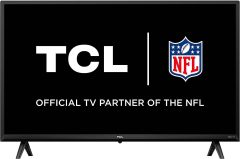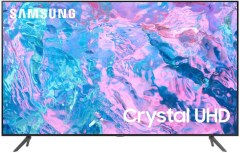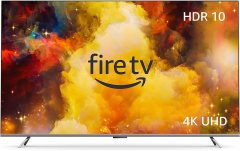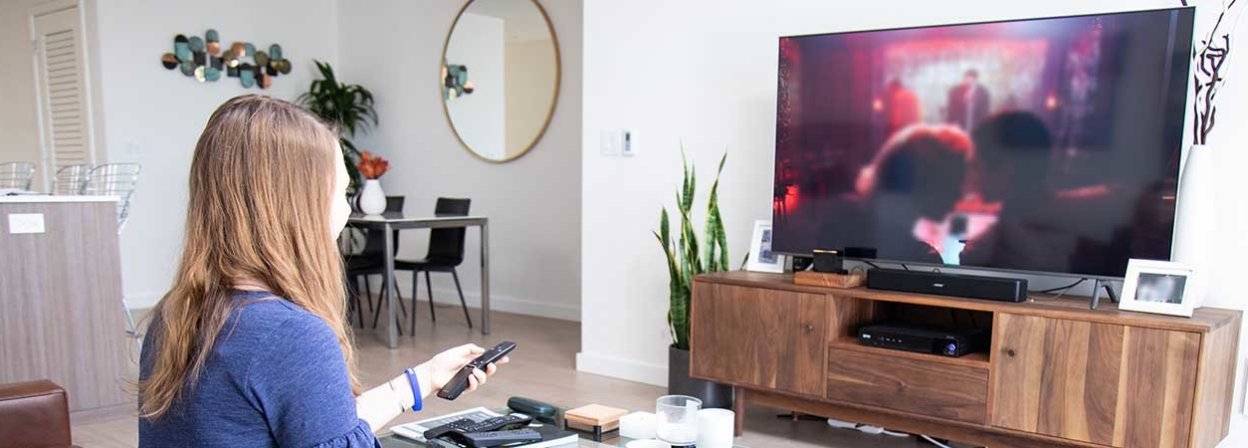BestReviews is reader-supported and may earn an affiliate commission. Details

A 65" smart TV with Samsung's glare-free Matte Display and famous Art Mode while the unit rests.
The 4K QLED screen is crystal clear with brilliant, clear, colorful detail. Displays images during Art Mode and includes Samsung's Art Store. Slim-fit wall mount hangs close to the wall. Features built-in Alexa functionality with voice controls.
Art Mode requires a subscription. The software frustrates some.

Great for a small apartment or bedroom, this 32-inch TCL Smart TV is a bargain.
High-definition 720p resolution Roku TV. Ideal for streaming movies, TV shows, and live sports. Download your favorite streaming services and customize the home screen so you can effortlessly stream. Features voice control compatible with Siri, Alexa, or Hey Google.
There is a white LED light that is on even when the TV is off which may be disruptive in dark rooms or bedrooms.

This large, 65-inch smart TV has incredible picture quality and is powered by Google.
Vibrant and true-color picture quality thanks to Triluminos Pro technology. Boasts 4K, HDR video with Dolby Vision for high contrast color. Super narrow bezel means the screen is completely flush with the frame. Designed for seamless compatibility with PlayStation 5 and streaming supported by Google TV.
This TV has has some bugs when it comes to connecting with Apple TV and Xfinity.

Thrifty Xbox and PlayStation owners should consider adopting this sharp and vibrant TV for reliably smooth gameplay.
Crystal-clear and colorful 4K UHD display. Features 4K upscaling. User-friendly smart TV functionality. Voice control. Immersive audio. Optimized for console gaming. Slim profile.
Not the brightest TV on the market.

Deep Alexa integration makes this TV worthwhile, according to our testing.
Designed by Amazon with its popular Fire interface and Prime streaming service. Also can access other popular streaming services. Vivid 4K picture with Dolby Vision. Provides deep Alexa integration for controls and options.
Picture quality did not impress particularly in testing. The 60Hz refresh rate lags behind competitors.

We recommend these products based on an intensive research process that's designed to cut through the noise and find the top products in this space. Guided by experts, we spend hours looking into the factors that matter, to bring you these selections.

Way back when the iPhone first introduced the world to apps, no one could have predicted that apps would soon take over nearly every screen, but now they’re everywhere, even TVs.
TVs with apps, dubbed smart TVs, can connect to the internet as well as interact with other web-enabled devices. They deliver everything from your favorite binge-worthy shows to the most addictive games. In fact, now when you buy a TV, you’re not just buying a screen; you’re buying an entertainment platform. Understandably, then, you would want to learn more about the details: which type to get, how much to expect to pay, and how to make the most of your investment.

Smart TVs wirelessly connect to the internet to provide access to streaming services and other online portals. There are two main means by which a TV can be smart. High-end companies boast their own smart platform that they include in their TVs. These are typically more expensive than TVs that integrate another company’s smart platform. These popular options include Android TV by Google, Fire TV by Amazon, and Roku TV. While these options are versatile and accessible, they are not as fast as the higher-end options.
By far the most popular apps are those that connect viewers to their favorite subscription-based streaming services. The smart platform allows you access to Netflix, Amazon Prime Video, Apple TV, Disney+, Hulu, Paramount+ or any other major service, so you can start bingeing your favorite TV shows in no time.
If you’re a fan of mobile games like Candy Crush or Farmville, you’ll find a lot to love with this kind of TV. Many of today’s options support popular titles imported from Android and iOS smartphones. Just be prepared for the fact that, in some cases, you’ll need to use the TV remote as a game controller, which can feel clunky at first.
Depending on the smart platform, you may have access to social media services as well, allowing you to browse and scroll. You’ll want to connect the keyboard if you’re interested in posting written content.
Some TVs feature a smartcast function, which allows you to throw content from a smartphone or tablet to the TV, provided all devices are on the same WiFi network. This is most accessible if you have a device that matches the technology of the TV or smart platform. However, some apps are compatible across different brands.
In lieu of casting, some TVs may be controlled by a voice assistant with platforms utilizing Amazon’s Alexa or Google Assistant.
Screen size is among the most important considerations when you are shopping. It is measured diagonally from one corner to the other and is typically offered in 5- to 10-inch increments. You’ll want to measure your available space in order to find a TV that fits your space. For those who plan to sit 6 to 9 feet from the screen, it’s recommended that you choose a TV of 50 to 60 inches. Adjust your dimensions accordingly for smaller and larger spaces.
Most medium-size rooms will be well-served by a 55-inch or 65-inch TV. Smaller options hover around the 40-inch range. These are ideal for dens or bedrooms. The largest choices hit 85 inches in size; choose something like this for the most immersive viewing experience possible.
A TV’s refresh rate is the frequency with which the image reproduces itself every second. The standard rate, measured in Hertz, is 60 Hz. While this suffices for most content, it can lead to a lag when you’re watching live sports, action-heavy films, and video games. Simply put, a higher rate reduces motion blur associated with such content. If you enjoy sports or gaming, look for rates of 75Hz or higher, up to 144Hz. Rates above 144Hz exist, though the differences may not be easily seen or at all perceptible to the naked eye.
While higher refresh rates can help make sports and action look less blurry, the effect also attempts to smooth out regular content, resulting in everything looking hyper-realistic. This is often referred to as the "soap-opera effect" since the visual effect reminds viewers of the cheap simplicity of a daytime soap opera. Because most people prefer to see content as the creators intended, it’s usually best to turn off high refresh rates
Most companies, including Sony and LG, enhance the rate with their own technology, leading to higher rates that may reach 240 Hz. In these cases, they will boast a number that is simulated or enhanced while also noting the native number, which will still be from 60 Hz to 120Hz. These technologies work, but keep in mind the difference between their rate and the native number.




















The most important factor when shopping for any type of TV is the screen, both in terms of picture resolution and picture quality. Before you start shopping, decide what your ideal resolution is and what type of TV panel you want.
You’ll need to decide if you want high definition (with a resolution of 1920 x 1080, often referred to as 1080p, Full HD, or FHD), or ultra-high definition (with a resolution of 3840 x 2160, better known as 4K). Higher-resolution screens produce more detailed images, so if you want the best picture quality you can get, spring for a 4K TV, also known as a UHD TV. If you just want good picture quality and don’t need it to be intensely detailed, a 1080p HDTV set would serve you just fine.
As technology continues to advance, 4K is becoming the standard resolution. New major films and most high-end TV shows are filmed in 4K, and most streaming content is available in a 4K tier as well. Granted, most 4K options will upscale lesser-quality content, but it’s important to make sure you have access to 4K content to enjoy the TV’s potential. That means investing in a 4K cable box or 4K player with discs or subscribing to a service that offers 4K content. The option for an 8K TV also exists, but they are not a great choice for the price since there is no 8K content to watch.
HDR, or high dynamic range, informs color brightness and accuracy. HDR10+ and Dolby Vision are the latest technologies and aer typically paired with 4K resolution to deliver colorful, detailed content. It allows for deeper blacks and greater contrast as well as brighter whites. Like 4K resolution, you’ll need HDR-compatible content in order to enjoy this.
Several competing screen technologies are available, but the main two are OLED and LED.
An OLED screen is vastly superior to an LED screen because each pixel is individually lit, resulting in a brighter image. However, products with these screens are also about three times as expensive as products with other screens. Nothing is better than OLED. There are all kinds of names now to make them sound the same: QLED, XLED, ULED, etc., and those can look pretty good, but none of these outperform OLED.
LEDs comprise a wide range of options, including budget-friendly TVs as well as higher-quality models. Some companies may offer their own proprietary type of LED TV made with their own technology. LCD TV is a dated version of an LED TV, but it uses the same technology.
Edge-lit LED TVs have been common over the years. On these models, the screen is lit from the sides. Full-array TVs are slightly different. They feature zones of backlighting so you can localize dimming, resulting in finer images and detail with higher contrast.
Soundbar: Bose Smart Soundbar 300
While the TVs we’ve been discussing are optimized for stunning visuals and smart service integration, they often lack high-quality audio. Consider investing in a soundbar like this option from Bose to support deeper bass and crisper dialogue.
Blu-ray player: LG Region-Free Blu-Ray Player
Although you’ll have access to streaming service, a disc player can provide a reliable and quality connection without relying on WiFi. For those who enjoy physical copies of content, consider this LG HD player.
TV mount: VideoSecu Articulating Full-Motion Bracket
A lot of consumers decide to mount their new purchase on the wall to save space and maximize viewability. This option is easy to install, it can hold a lot of weight, and you can select the size you need. No need to pay for more than you need.
Home theater seating: Flash Furniture Reclining Theater Seating
For family movie night or hanging out with friends, nothing beats having a set of comfy reclining seats to make the most of your experience. Flash Furniture offers their reclining chairs in configurations of two or three. Pop some popcorn, sit back, and relax.

Before you start shopping, it helps to know how far your money will go. Keep these prices in mind as you survey the market.
Between $300 and $799, you’ll find great choices when it comes to 1080p and bare-bones 4K options. If you just want a basic HDTV, you don’t need to spend a lot to get a solid deal. However, if you’re looking for 4K with all the bells and whistles, such as high dynamic range or an OLED screen, you’ll need to spend more.
Between $800 and $1,299, many products feature 4K resolution, but some skimp on other features. For example, some low-end 4K options have multiple inputs but only one that supports 4K content. The majority of 4K TVs in this price range are average, which is still incredible.
Between $1,300 and $3,500, expect to find options that spare no expense. In this price range are 4Ks with features like HDR and Dolby Vision and higher-end screen panel technologies like XLED, QLED, or OLED. Most can anchor a solid home theater, so if you’re ready to turn your living room into a personal cinema, get ready to write a check with a comma in it.
Mount your TV. Not only does mounting save space, it typically allows for a more comfortable and immersive viewing experience.
If sound quality is a key concern, consider a smart TV bundled with a soundbar. Buying a soundbar that has already been paired with a TV removes all doubt about equipment compatibility.
Never clean your screen with a commercial spray cleaner. No matter what kind of screen you have, it should only be cleaned with water, and sparingly. Most cleaning products use chemicals that can harm or stain a TV screen, so only use microfiber cloths and a small amount of water. For best results, spray water on the cloth and then wipe the TV. Never spray the screen directly, not even with water.
Set the software to update automatically. TV makers often publish software updates that bring new features and critical security fixes to your TV. It’s easy to forget to check for software updates, so save yourself the headache and set your TV to auto-update. With auto-update, all-important software updates happen in the background as soon as they’re available.
Cover a built-in TV webcam when you’re not using it. Some of these TVs are designed to facilitate video calls, so they include webcams at the top of the screen that seamlessly integrate with the TV design. Having a webcam can be great: it’s perfect for staying connected with friends and family. However, many privacy advocates aren’t thrilled about having an internet-connected camera pointed at them while they watch TV. If you have concerns about privacy, cover your webcam with a discreet piece of electrical tape, or choose an option without a camera.

A. Yes, you can do this as long as the TV has a coaxial input. Most of these TVs have a coaxial input that you can use with an external antenna; the coaxial input indicates the TV has a tuner inside that can translate your local broadcast TV signals into a watchable picture. However, some companies omit a coaxial input or TV tuners, most notably LG.
The easiest way to tell which models have coaxial inputs and TV tuners is to note the product titles. If a set has a tuner, it will be marketed as a TV. If it does not, it will simply be called a display. When shopping, you’re likely to encounter both, so pay special attention to which models use the word “TV” and which use the word “display.”
A. Yes, you will need this if you want to use a paid service. Most of these TVs come with a host of apps that are free to download and use, but they also support the most popular services, like Netflix, Hulu, Vudu, and Amazon Video. To learn more about paid subscriptions, visit each streaming provider’s website.
A. Yes, as long as you follow web security best practices. For example, it’s important that your TV operating system is up to date to make sure that the latest patches and security features have been installed. If you keep your hardware updated (particularly gadgets that get you the internet, like your wireless router), your risk is minimal.
In addition to keeping software current, it’s important to secure any accounts you’ll be using with it. For example, if you plan on browsing Facebook on television, make sure you’ve protected your Facebook account with multi-factor authentication to prevent getting hacked. For each account you plan on using with the TV, investigate what security features you can enable to protect your data and credentials.
Get emails you’ll love.
Learn about the products you’re wondering if you should buy and get advice on using your latest purchases.
